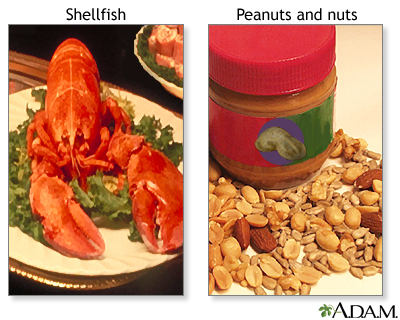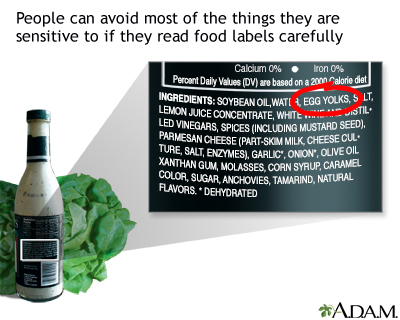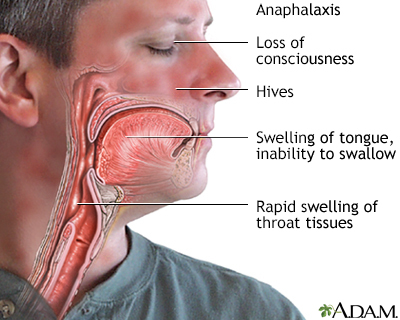Know the Signs of a Food Allergy
May 13 starts Food and Allergy Awareness week, recognizing the 15 million Americans who are affected by food allergies. Such allergies happen when the body…

Update your location to show providers, locations, and services closest to you.
A food allergy is type of immune response triggered by eggs, peanuts, milk, shellfish or some other specific food.
Allergy to food; Food allergy - peanuts; Food allergy - soy; Food allergy - fish; Food allergy - shellfish; Food allergy - eggs; Food allergy - milk
Many people have a food intolerance. This term usually refers to heartburn, cramps, belly pain, or diarrhea that can occur after they eat foods such as:
A true food allergy is much less common.
The immune system normally protects the body against harmful substances, such as bacteria and viruses. It also reacts to foreign substances called allergens. These are usually harmless, and in most people, do not cause a problem.

In a person with a food allergy, the immune response is oversensitive. When it recognizes an allergen, the immune system launches a response. Chemicals such as histamines are released. These chemicals cause allergy symptoms.
Any food can cause an allergic reaction. The most common food allergies are to:
In rare cases, food additives, such as dyes, thickeners, and preservatives can cause a food allergy or intolerance reaction.
Some people have an oral allergy. This is an allergy type syndrome that affects the mouth and tongue after they eat certain fresh fruits and vegetables:
Symptoms usually begin within 2 hours after eating. Sometimes, the symptoms begin hours after eating the food.
Key symptoms of a food allergy include hives, a hoarse voice, and wheezing.
Other symptoms that may occur include:

Symptoms of mouth (oral) allergy syndrome:
In a severe reaction, called anaphylaxis, in addition to the above symptoms, you may have low blood pressure and blocked airways. This can be life threatening.
Blood or skin tests are sometimes used to confirm that you have an allergy. A double-blind food challenge is one way to diagnose true food allergies. During this test, you and your health care provider will not know what you are eating.
With elimination diets, you avoid the suspected food until your symptoms disappear. Then you start eating the foods again to see if you develop an allergic reaction.
In provocation (challenge) testing, you eat a small amount of the suspected food under medical supervision. This type of test may cause severe allergic reactions. Challenge testing should only be done by a trained provider.
Never try to cause a reaction or reintroduce a food on your own. These tests should only be done under the guidance of a provider, especially if your first reaction was severe.
If you suspect that you or your child has a food allergy, see an allergy specialist doctor (allergist).
Treatment may involve any of the following:
Other treatments, including allergy shots and probiotics, have not been proven to help with food allergies.
If your child has a problem with cow's milk formula, your provider may suggest trying a soy-based formula or something called an elemental formula, if it is available.
If you have symptoms on only one area of the body, for example, a hive on the chin after eating the food, you may not need any treatment. The symptoms will likely go away in a brief time. Antihistamines may relieve the discomfort. Soothing skin creams may also provide some relief.
If you have been diagnosed with a food allergy, learn how to use injectable epinephrine. You should have it with you at all times. If you develop any type of serious or whole-body reaction (even hives) after eating the food:
The following groups can provide more information about food allergies:
Allergies to peanuts, tree nuts, and shellfish tend to last a lifetime.

Avoiding the problem foods may be easy if the food is uncommon or easy to identify. When eating away from home, ask detailed questions about the food you are served. When buying food, read package ingredients carefully.

Anaphylaxis is a severe, whole-body allergic reaction that is life threatening. Although people with oral allergy syndrome may have an anaphylactic reaction in rare cases, they should ask their doctor if they need to carry injectable epinephrine.
Food allergies can trigger or worsen asthma, eczema, or other disorders.
Steps to take when a food allergy reaction occurs:
Breastfeeding may help prevent allergies. Otherwise, there is no known way to prevent food allergies.
A common belief and practice is to delay introducing allergy-causing foods to infants until their gastrointestinal tract has had a chance to mature. The timing for this varies from food to food and from baby to baby.
Avoiding peanuts in early childhood does not appear to prevent, and may even enhance, the development of peanut allergy. Doctors now suggest introducing peanut-containing foods to infants, which may prevent peanut allergy. Talk to your child's provider to learn more.
Once an allergy has developed, carefully avoiding the offending food usually prevents further problems.





Bird JA, Jones S, Burks W. Food allergy. In: Rich RR, Fleisher TA, Shearer WT, Schroeder HW, Frew AJ, Weyand CM, eds. Clinical Immunology: Principles and Practice. 5th ed. Philadelphia, PA: Elsevier; 2019:chap 45.
Sicherer SH, Lack G, Jones SM. Food allergy management. In: Burks AW, Holgate ST, O'Hehir RE, et al, eds. Middleton's Allergy: Principles and Practice. 9th ed. Philadelphia, PA: Elsevier; 2020:chap 82.
Togias A, Cooper SF, Acebal ML, et al. Addendum guidelines for the prevention of peanut allergy in the United States: report of the National Institute of Allergy and Infectious Diseases-sponsored expert panel. J Allergy Clin Immunol. 2017;139(1):29-44. PMID: 28065278 pubmed.ncbi.nlm.nih.gov/28065278/.


May 13 starts Food and Allergy Awareness week, recognizing the 15 million Americans who are affected by food allergies. Such allergies happen when the body…

New mothers who want to reduce their child’s risk of developing food allergies should add one item to their grocery list: milk. A study involving more than 500 Swedish women has linked milk...
Many Americans take extra care checking food packaging for allergen information. This is good practice considering food allergies can be potentially life-threatening. Researchers from Lurie’s...
Americans typically associate food allergies with children, but new research suggests that nearly half of all food allergies begin during adulthood. While children often have nut or shellfish...